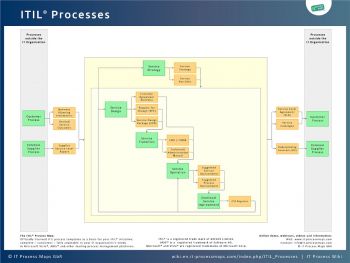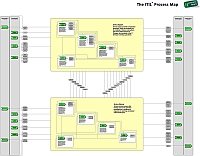ITIL Processes: Difference between revisions
mNo edit summary |
No edit summary |
||
| Line 1: | Line 1: | ||
< | <itpmch><title>ITIL Processes | IT Process Wiki</title> | ||
<meta name="keywords" content="itil processes, itil process, itil v3 processes, itil v2 processes, itil stages" /> | |||
<meta name="description" content="ITIL processes according to ITIL 2011. ITIL process definitions: Service Strategy, Service Design, Service Transition, Service Operation, CSI." /> | |||
</itpmch> | |||
<imagemap> | <imagemap> | ||
Image:ITIL-Wiki-de-es.jpg|DE - ES - ITIL Processes - Processes ITIL V3|100px | Image:ITIL-Wiki-de-es.jpg|DE - ES - ITIL Processes - Processes ITIL V3|100px | ||
| Line 8: | Line 11: | ||
<br style="clear:both;"/> | <br style="clear:both;"/> | ||
<html><div itemscope="itemscope" itemtype="https://schema.org/WebPage"><!-- define schema.org/WebPage --><p></html> | |||
<p> </p> | |||
= | |||
---- | |||
'''<span id="Overview">Objective:</span>''' <html><span itemprop="description">The <i><span itemprop="name Headline"><span itemprop="alternativeHeadline">ITIL</span> processes</span></i> within <span itemprop="specialty">IT Service Management (ITSM)</span> ensure that IT Services are provided in a focused, client-friendly and cost-optimized manner. With their help, IT Services are clearly defined, success can be measured with regards to the service provision, and targeted improvement measures can be introduced where necessary.</span></html> | |||
<p> </p> | <p> </p> | ||
__TOC__ | |||
===<span id="ITIL_V3_Processes">ITIL Processes according to ITIL 2011</span>=== | |||
---- | |||
[[Image:Itil-processes.jpg|thumb|350px|right|none|alt=ITIL processes|Fig. 1: Service Lifecycle - [https://wiki.en.it-processmaps.com/images/pdf/itil_v3_service_lifecycle_itil-process-map-v3.pdf ITIL Processes]]] | |||
====<span | <html><div itemscope="itemscope" itemtype="https://schema.org/ItemList"><!-- define schema.org/ItemList --> | ||
Process Objective: To build and deploy IT services. | <meta itemprop="itemListOrder" content="Ascending" /> | ||
<p><span itemprop="name" content="ITIL processes - The ITIL Service Lifecycle:">In <i>ITIL 2011 (ITIL V3 2011 Edition)</i> the ITIL processes are grouped into stages:</span> Service Strategy, Service Design, Service Transition, Service Operation, and Continual Service Improvement (see <a href="https://wiki.en.it-processmaps.com/images/7/75/Itil-processes.jpg" title="ITIL Processes: The ITIL 2011 Service Lifecycle">Fig. 1</a>). Each of the five stages is focused on a specific phase of a service's lifecycle:</p> | |||
<p> </p> | |||
Process Objective: To make sure that IT services are delivered effectively and efficiently. | <dl><dt><span id="ITIL_Processes_Strategy"><a href="https://wiki.en.it-processmaps.com/index.php/ITIL_Service_Strategy" title="ITIL Service Strategy" itemprop="itemListElement">Service Strategy</a></span> | ||
</dt><dd itemprop="description">Process Objective: To decide on a strategy to serve customers. Starting from an assessment of customer needs and the market place, the Service Strategy process determines which services the IT organization is to offer and what capabilities need to be developed. Its ultimate goal is to make the IT organization think and act in a strategic manner. | |||
</dd></dl> | |||
<p><br /> | |||
</p> | |||
<dl><dt><span id="ITIL_Processes_Design"><a href="https://wiki.en.it-processmaps.com/index.php/ITIL_Service_Design" title="ITIL Service Design" itemprop="itemListElement">Service Design</a></span> | |||
</dt><dd itemprop="description">Process Objective: To design new IT services. The scope of the process includes the design of new services, as well as changes and improvements to existing ones. | |||
</dd></dl> | |||
<p><br /> | |||
</p> | |||
<dl><dt><span id="ITIL_Processes_Transition"><a href="https://wiki.en.it-processmaps.com/index.php/ITIL_Service_Transition" title="ITIL Service Transition" itemprop="itemListElement">Service Transition</a></span> | |||
</dt><dd itemprop="description">Process Objective: To build and deploy IT services. Service Transition also makes sure that changes to services and Service Management processes are carried out in a coordinated way. | |||
</dd></dl> | |||
<p><br /> | |||
</p> | |||
<dl><dt><span id="ITIL_Processes_Operation"><a href="https://wiki.en.it-processmaps.com/index.php/ITIL_Service_Operation" title="ITIL Service Operation" itemprop="itemListElement">Service Operation</a></span> | |||
</dt><dd itemprop="description">Process Objective: To make sure that IT services are delivered effectively and efficiently. The Service Operation process includes fulfilling user requests, resolving service failures, fixing problems, as well as carrying out routine operational tasks. | |||
</dd></dl> | |||
<p><br /> | |||
</p> | |||
<dl><dt><span id="ITIL_Processes_Improvement"><a href="https://wiki.en.it-processmaps.com/index.php/ITIL_CSI_-_Continual_Service_Improvement" title="ITIL CSI - Continual Service Improvement" itemprop="itemListElement">Continual Service Improvement - CSI</a></span> | |||
</dt><dd itemprop="description">Process Objective: To use methods from quality management in order to learn from past successes and failures. The Continual Service Improvement process aims to continually improve the effectiveness and efficiency of IT processes and services, in line with the concept of continual improvement adopted in ISO 20000. | |||
</dd></dl> | |||
</div><!-- end of schema.org/ItemList --><p></html> | |||
<p> </p> | |||
<p> </p> | <p> </p> | ||
| Line 39: | Line 60: | ||
---- | ---- | ||
[[Image:thumb_high_level_view_itil_v2_it_service_management.jpg|frame|left|alt=Processes ITIL V2|The ITIL V2 Process Map showing the greater associations between the [https://en.it-processmaps.com/media/poster_itil_process_map.pdf ITIL Processes]]] | [[Image:thumb_high_level_view_itil_v2_it_service_management.jpg|frame|left|alt=Processes ITIL V2|Fig. 2: The ITIL V2 Process Map showing the greater associations between the [https://en.it-processmaps.com/media/poster_itil_process_map.pdf ITIL Processes]]] | ||
IT Service Management according to ITIL V2 | Unlike ITIL V3 2011 and 2007, IT Service Management according to ITIL version 2 was not organized around the service lifecycle. ITIL V2 contained the following "disciplines": | ||
= | <p> </p> | ||
The ITIL discipline Service Support provides all operative Processes necessary for the handling of Service interruptions and for the implementation of Changes; the availability of the IT Services is thereby guaranteed. | |||
;<span id="ITIL_Processes:_Service_Support">[[Service Support]]</span> | |||
:The ITIL discipline Service Support provides all operative Processes necessary for the handling of Service interruptions and for the implementation of Changes; the availability of the IT Services is thereby guaranteed. | |||
<br /> | |||
;<span id="ITIL_Processes:_Service_Delivery">[[Service Delivery]]</span> | |||
:The ITIL discipline Service Delivery ensures that binding rules for the operative Processes are in existence. It regulates the planning, contractual and financial topics. | |||
<br style="clear:both;"/> | |||
<br style="clear:both;"/> | <br style="clear:both;"/> | ||
<html><a rel="author" href="https://plus.google.com/111925560448291102517"><img style="margin:0px 0px 0px 0px;" src="/skins/Vector/images/itpm/bookmarking/gplus.png" width="16" height="16" title="By: Stefan Kempter | Profile on Google+" alt="Author: Stefan Kempter, IT Process Maps GbR" /></a></html> | ==[ Infobox ]== | ||
<html><table class="wikitable"> | |||
<tr> | |||
<td>Link to this page:</td> | |||
<td><a itemprop="url" href="https://wiki.en.it-processmaps.com/index.php/ITIL_Processes">https://wiki.en.it-processmaps.com/index.php/ITIL_Processes</a></td> | |||
</tr> | |||
<tr> | |||
<td>Languages:</td> | |||
<td><span itemprop="inLanguage" content="en">English</span> | <span><a itemprop="citation" class="external text" href="https://wiki.de.it-processmaps.com/index.php/ITIL-Prozesse" title="ITIL-Prozesse">Deutsch</a></span> | <span><a itemprop="citation" class="external text" href="https://wiki.es.it-processmaps.com/index.php/Procesos_ITIL" title="Procesos ITIL">español</a></span></td> | |||
</tr> | |||
<tr> | |||
<td>Image:</td> | |||
<td style="vertical-align:top"><a itemprop="primaryImageOfPage" href="https://wiki.en.it-processmaps.com/images/7/75/Itil-processes.jpg" title="ITIL Processes: The ITIL Service Lifecycle according to ITIL 2011">ITIL 2011 Processes - The ITIL Service Lifecycle (.JPG)</a></td> | |||
</tr> | |||
<tr> | |||
<td>Is based on:</td> | |||
<td style="vertical-align:top"><a itemprop="isBasedOnUrl" href="https://en.it-processmaps.com/products/itil-process-map.html" title="The ITIL Process Map: Reference Process Model - ITIL V3 (2011 Edition)" class="external text">ITIL reference processes from the ITIL Process Map</a></td> | |||
</tr> | |||
<tr> | |||
<td>Author:</td> | |||
<td><span itemprop="author">Stefan Kempter</span>, <span itemprop="creator copyrightHolder publisher">IT Process Maps</span> <a rel="author" href="https://plus.google.com/111925560448291102517"><img style="margin:0px 0px 0px 0px;" src="/skins/Vector/images/itpm/bookmarking/gplus.png" width="16" height="16" title="By: Stefan Kempter | Profile on Google+" alt="Author: Stefan Kempter, IT Process Maps GbR" /></a></td> | |||
</tr> | |||
</table> | |||
<p><small> | |||
<span itemscope="itemscope" itemtype="http://data-vocabulary.org/Breadcrumb"> | |||
<a href="https://wiki.en.it-processmaps.com/index.php/ITIL_Processes#ITIL_Processes_according_to_ITIL_2011" itemprop="url"><span itemprop="title">ITIL 2011 Processes</span></a> › | |||
</span> | |||
<span itemscope="itemscope" itemtype="http://data-vocabulary.org/Breadcrumb"> | |||
<a href="https://wiki.en.it-processmaps.com/index.php/ITIL_Service_Strategy" itemprop="url"><span itemprop="title">Service Strategy</span></a> › | |||
</span> | |||
<span itemscope="itemscope" itemtype="http://data-vocabulary.org/Breadcrumb"> | |||
<a href="https://wiki.en.it-processmaps.com/index.php/ITIL_Service_Design" itemprop="url"><span itemprop="title">Service Design</span></a> › | |||
</span> | |||
<span itemscope="itemscope" itemtype="http://data-vocabulary.org/Breadcrumb"> | |||
<a href="https://wiki.en.it-processmaps.com/index.php/ITIL_Service_Transition" itemprop="url"><span itemprop="title">Service Transition</span></a> › | |||
</span> | |||
<span itemscope="itemscope" itemtype="http://data-vocabulary.org/Breadcrumb"> | |||
<a href="https://wiki.en.it-processmaps.com/index.php/ITIL_Service_Operation" itemprop="url"><span itemprop="title">Service Operation</span></a> › | |||
</span> | |||
<span itemscope="itemscope" itemtype="http://data-vocabulary.org/Breadcrumb"> | |||
<a href="https://wiki.en.it-processmaps.com/index.php/ITIL_CSI_-_Continual_Service_Improvement" itemprop="url"><span itemprop="title">CSI</span></a> | |||
</span> | |||
</small></p> | |||
</div><!-- end of schema.org/WebPage --><p></html> | |||
<!-- This page is assigned to the following categories: --> | <!-- This page is assigned to the following categories: --> | ||
[[Category:ITIL stage|!]][[Category:ITIL discipline|!]][[Category:ITIL process|!]] | [[Category:ITIL stage|!]][[Category:ITIL discipline|!]][[Category:ITIL process|!]] | ||
<!-- --- --> | <!-- --- --> | ||
Revision as of 20:05, 9 December 2013

Objective: The ITIL processes within IT Service Management (ITSM) ensure that IT Services are provided in a focused, client-friendly and cost-optimized manner. With their help, IT Services are clearly defined, success can be measured with regards to the service provision, and targeted improvement measures can be introduced where necessary.
ITIL Processes according to ITIL 2011

In ITIL 2011 (ITIL V3 2011 Edition) the ITIL processes are grouped into stages: Service Strategy, Service Design, Service Transition, Service Operation, and Continual Service Improvement (see Fig. 1). Each of the five stages is focused on a specific phase of a service's lifecycle:
- Service Strategy
- Process Objective: To decide on a strategy to serve customers. Starting from an assessment of customer needs and the market place, the Service Strategy process determines which services the IT organization is to offer and what capabilities need to be developed. Its ultimate goal is to make the IT organization think and act in a strategic manner.
- Service Design
- Process Objective: To design new IT services. The scope of the process includes the design of new services, as well as changes and improvements to existing ones.
- Service Transition
- Process Objective: To build and deploy IT services. Service Transition also makes sure that changes to services and Service Management processes are carried out in a coordinated way.
- Service Operation
- Process Objective: To make sure that IT services are delivered effectively and efficiently. The Service Operation process includes fulfilling user requests, resolving service failures, fixing problems, as well as carrying out routine operational tasks.
- Continual Service Improvement - CSI
- Process Objective: To use methods from quality management in order to learn from past successes and failures. The Continual Service Improvement process aims to continually improve the effectiveness and efficiency of IT processes and services, in line with the concept of continual improvement adopted in ISO 20000.
ITIL Processes according to ITIL Version 2 (ITIL V2)

Unlike ITIL V3 2011 and 2007, IT Service Management according to ITIL version 2 was not organized around the service lifecycle. ITIL V2 contained the following "disciplines":
- Service Support
- The ITIL discipline Service Support provides all operative Processes necessary for the handling of Service interruptions and for the implementation of Changes; the availability of the IT Services is thereby guaranteed.
- Service Delivery
- The ITIL discipline Service Delivery ensures that binding rules for the operative Processes are in existence. It regulates the planning, contractual and financial topics.
[ Infobox ]
| Link to this page: | https://wiki.en.it-processmaps.com/index.php/ITIL_Processes |
| Languages: | English | Deutsch | español |
| Image: | ITIL 2011 Processes - The ITIL Service Lifecycle (.JPG) |
| Is based on: | ITIL reference processes from the ITIL Process Map |
| Author: | Stefan Kempter, IT Process Maps |
ITIL 2011 Processes › Service Strategy › Service Design › Service Transition › Service Operation › CSI






